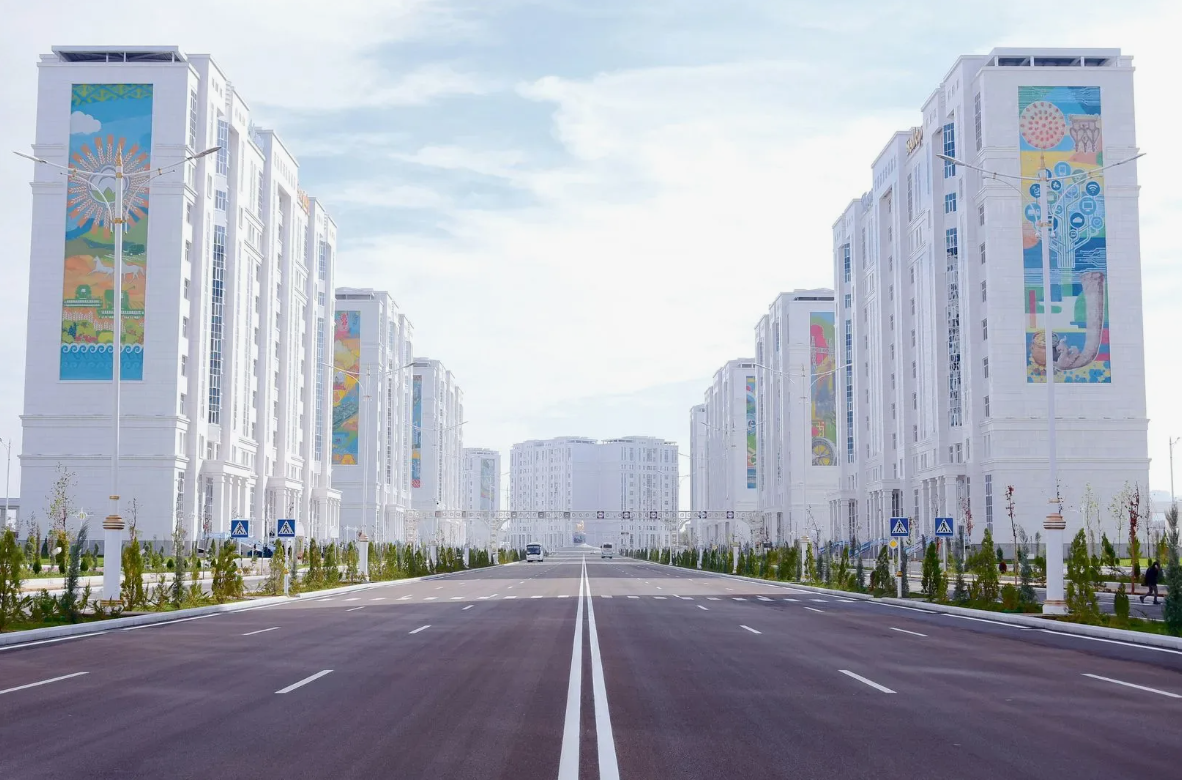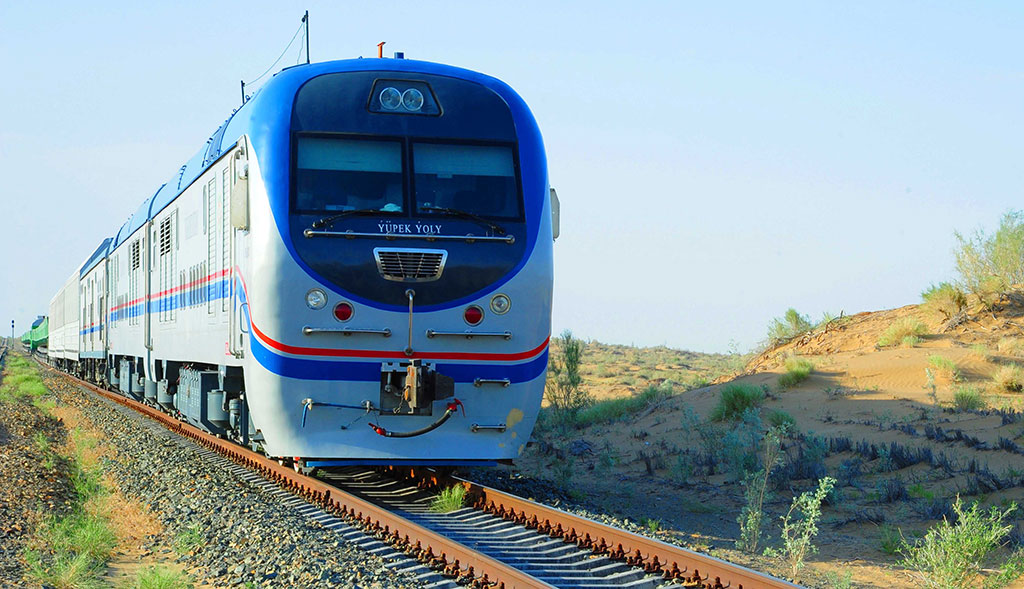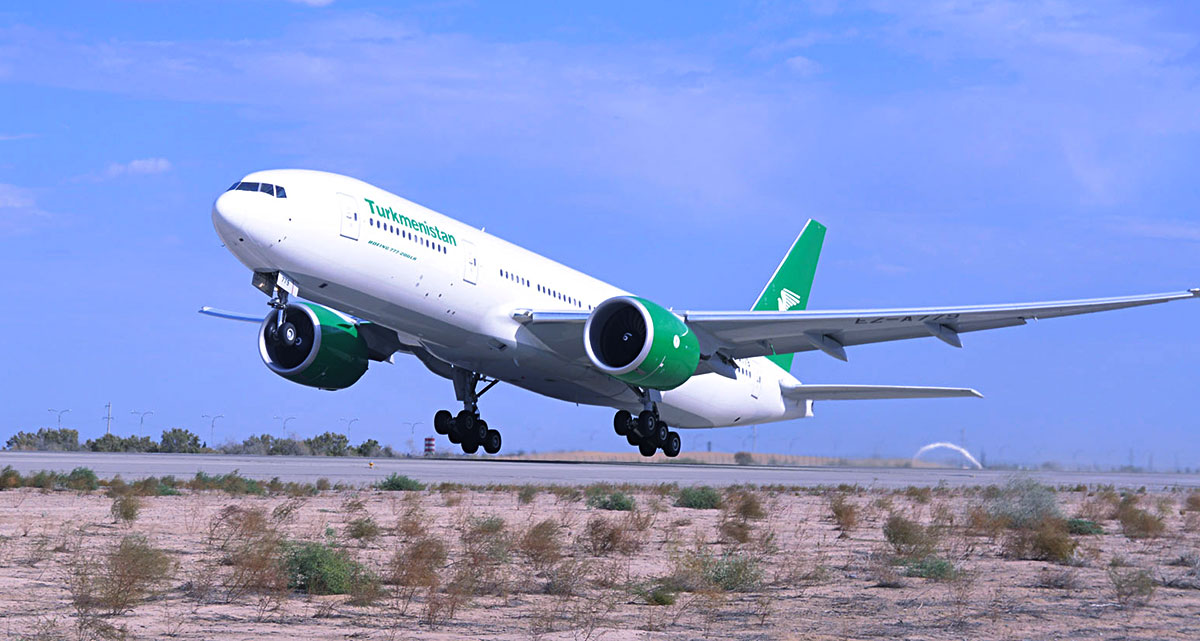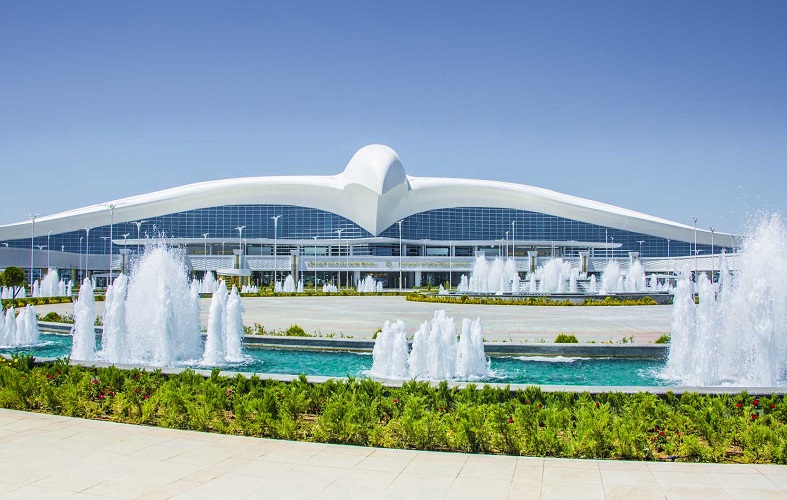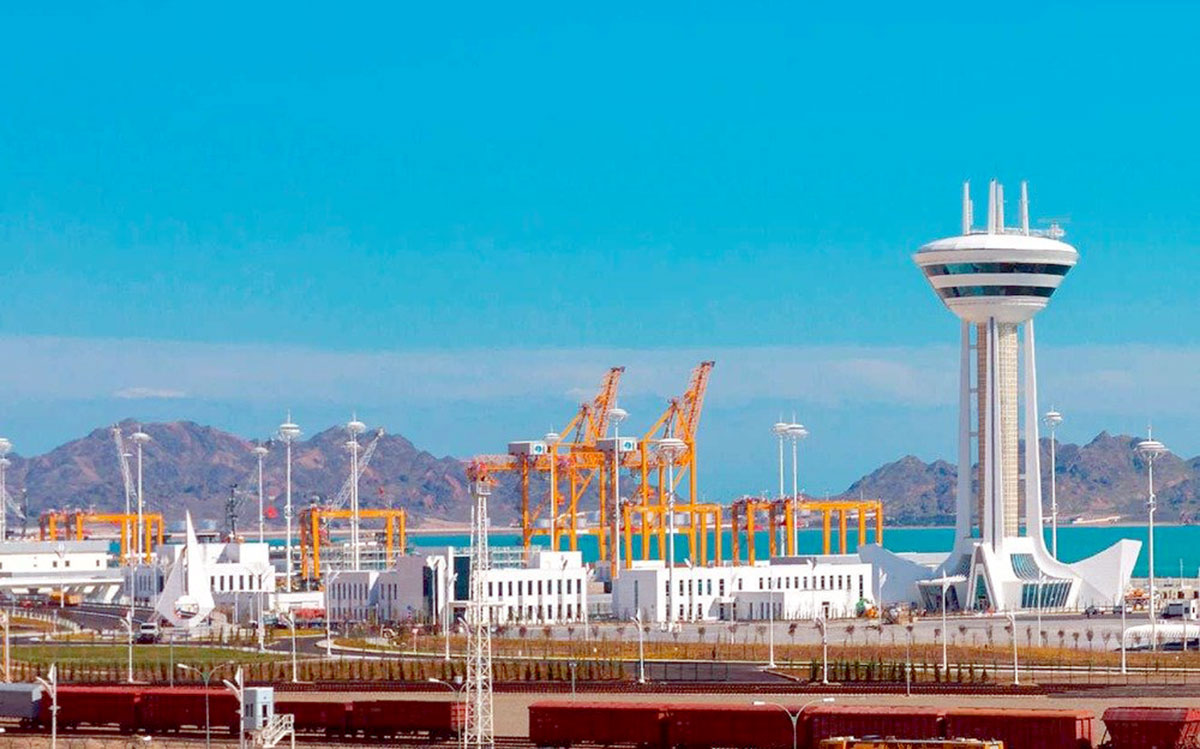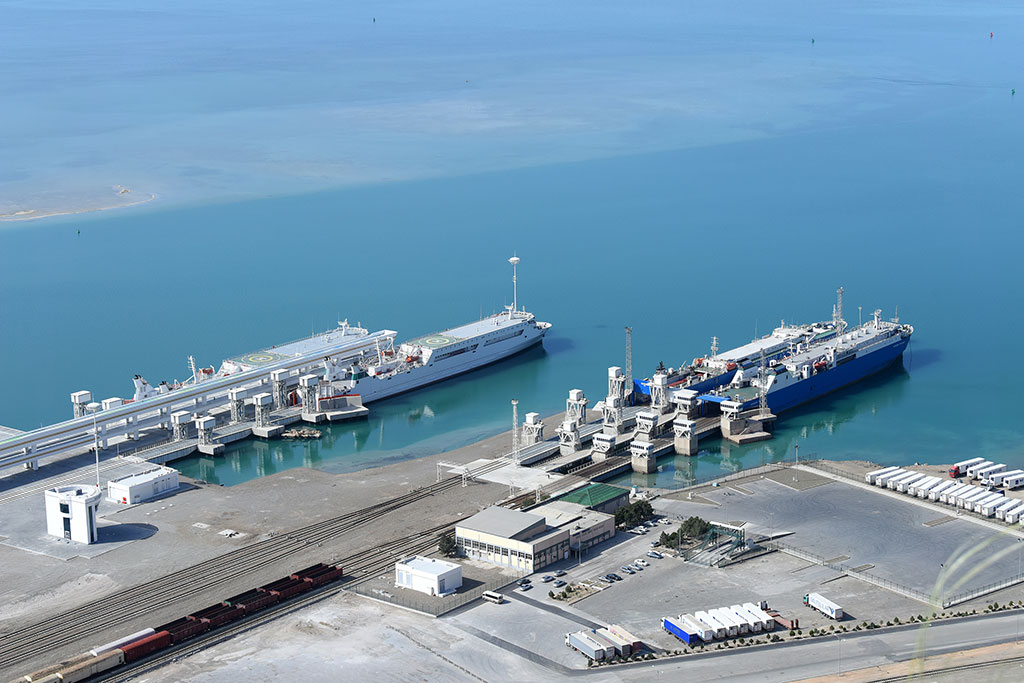Transport and Transit Corridors
Turkmenistan, strategically located at the geographical heart of Central Asia, plays a key role in shaping regional and international transport and transit corridors. With vast reserves of energy resources and through the implementation of large-scale infrastructural projects aimed at developing its transport network, Turkmenistan is actively striving to strengthen its position as a central link in the global transport system. The focus on modernising the country’s transport and transit sectors – including ongoing efforts to upgrade infrastructure, implement key projects, and engage in forward-looking planning – underscores Turkmenistan’s ambition to become a major transport hub of regional and international significance.
Turkmenistan's strategic geographical location at the crossroads of Asia, Europe, and the Middle East positions it as a pivotal transit hub for international trade and connectivity. Serving as a natural bridge between the energy-rich Central Asian region and global markets, the country is uniquely positioned with access to major trade routes such as the Caspian Sea, the Iranian border, and the China-Kyrgyzstan-Uzbekistan railway. These geographic advantages make Turkmenistan a crucial player in facilitating the movement of goods and services between Europe, Asia, and the Middle East. With its proximity to key regional and international corridors, Turkmenistan has a wealth of opportunities to strengthen its transport and transit infrastructure, enhancing both domestic connectivity and international trade relations.
In recent years, Turkmenistan has placed a significant emphasis on upgrading its transport corridors, which include road, rail, sea, and air networks. The government’s vision is to not only enhance internal connectivity but also to establish the country as a central transit route linking Europe, Asia, and the Middle East. As part of this overarching goal, Turkmenistan is actively modernizing and expanding its infrastructure to accommodate growing demand for both freight and passenger traffic.
A key element in Turkmenistan’s transport and transit strategy is its active participation in TRACECA (Transport Corridor Europe-Caucasus-Asia), a multilateral program initiated in 1993 to promote transportation and trade across Europe, the Caucasus, and Central Asia. As a member of TRACECA, Turkmenistan has played an integral role in developing essential infrastructure to support trade between the Caspian Sea region and broader European and Asian markets. TRACECA facilitates the movement of goods via road, rail, and sea, significantly improving Turkmenistan’s position as a crucial transit hub in the region. By strengthening regional cooperation, TRACECA ensures smoother cross-border transport, fostering regional integration and enhancing overall trade efficiency.
Through continuous investments in infrastructure along the TRACECA route, Turkmenistan is improving its connectivity to Europe, which will in turn boost trade volumes and improve the efficiency of supply chains. Furthermore, Turkmenistan's participation in TRACECA underscores its commitment to regional collaboration and its central role in facilitating international trade between Asia, Europe, and beyond. TRACECA not only provides an important avenue for Turkmenistan to enhance its strategic connectivity but also plays a vital role in promoting economic cooperation across the Eurasian continent.
Through these comprehensive infrastructure initiatives and multilateral frameworks, Turkmenistan is working diligently to solidify its position as a key player in regional and international trade, ensuring sustainable growth and strengthening its role in the global economy.
As Turkmenistan continues to revitalise the Great Silk Road in a modern context, it is increasingly positioning itself within the global transport and logistics framework. According to the article, the country is playing an active role in the construction of the 'golden ring' of the North-South transport and logistics corridor. This ambitious project aims to enhance connectivity and streamline the movement of goods across regional and international markets. Through the development and modernisation of critical infrastructure such as highways, bridges, and transport hubs, Turkmenistan is not only strengthening its role in global trade but also promoting economic growth and cooperation with neighbouring nations. This strategic development is solidifying the country’s status as a key player in regional and global transport networks.
The road transport sector, in particular, has seen substantial improvements. Turkmenistan has focused on expanding and modernizing its road network, particularly highways connecting major cities and industrial zones, in order to meet international standards. This development has been crucial for ensuring smoother domestic and cross-border transportation. Notably, the Turkmenistan-Afghanistan-Pakistan (TAP) road corridor stands out as one of the most ambitious projects. This corridor, once completed, will provide a direct land route between Central Asia and the Indian Ocean, significantly reducing transit times and enhancing the flow of goods between the regions. The TAP corridor is expected to catalyze trade, improve economic ties between Central and South Asia, and integrate Turkmenistan even further into the global supply chain.
In addition to road infrastructure, Turkmenistan has focused on the development of modern expressways and improved connectivity with neighboring countries such as Uzbekistan, Iran, and Kazakhstan. These efforts are aligned with the government’s goal of positioning Turkmenistan as a leading transit hub within Central Asia, which will enhance regional trade routes and encourage greater cooperation among the surrounding countries.
The rail sector is another area of major investment, with Turkmenistan undertaking several large-scale projects to enhance its rail connectivity both domestically and with neighboring countries. The expansion of the railway network is seen as crucial to supporting the country's efforts to position itself as a key player in regional transit.
In particular, the ongoing development of the Turkmenistan-Kazakhstan-China railway route is a game-changer for regional trade. The new railway line aims to connect Central Asia with China and further integrate Turkmenistan into the global supply chain. The railway will not only facilitate the movement of goods such as natural gas, oil, and cotton but also enable the country to offer a more efficient and cost-effective means of transportation for goods moving between East Asia, Europe, and the Middle East.
Moreover, Turkmenistan’s ongoing efforts to modernize its existing rail infrastructure, such as the construction of new rail stations and the electrification of key routes, further enhance the country's capacity to support both domestic and international freight movement.
In March 2025, Russia and Pakistan will launch their first direct freight train service through Turkmenistan to enhance bilateral trade. The service, part of the International North-South Transport Corridor, will bypass Afghanistan and pass through Kazakhstan, Turkmenistan, and Iran. The new route, initially running in test mode, is expected to reduce transit times and boost trade volumes. This development highlights Turkmenistan's strategic position as a key transit hub in regional trade, complementing ongoing projects like the Turkmenistan-Afghanistan-Pakistan-India (TAPI) gas pipeline, which strengthens energy links between Turkmenistan and South Asia.
Turkmenistan’s air transport infrastructure is undergoing dynamic growth, with a strong emphasis on modernizing airports and expanding the national airline’s capabilities. The country’s commitment to enhancing connectivity is reflected in state-of-the-art facilities, an upgraded fleet, and increasing international partnerships.
Ashgabat International Airport, the nation’s primary aviation hub, has been transformed into a world-class facility, offering seamless travel experiences and direct connections to major cities in Europe, Asia, and the Middle East. Beyond the capital, regional airports, including those in Dashoguz, Mary, Turkmenabat, and Turkmenbashi, have been upgraded to accommodate growing passenger and cargo demands, facilitating greater accessibility and economic growth.
As the country’s flagship carrier, Turkmenistan Airlines continues to enhance its fleet with modern, fuel-efficient aircraft, ensuring greater comfort, reliability, and efficiency for passengers and cargo services. With an expanding network of destinations, the airline is strengthening Turkmenistan’s role as a strategic aviation hub in Central Asia.
Turkmenistan is actively engaged in regional and international air transport agreements, reinforcing its position in the global aviation industry. By expanding air routes to key markets in Central Asia, the Middle East, and Southeast Asia, the country is fostering deeper trade, tourism, and cultural exchange opportunities.
In addition to Ashgabat International Airport, Turkmenistan is home to several modern airports that serve both domestic and international routes. Airports in Balkanabat, Dashoguz, Kerki, Mary, Turkmenbashi, Turkmenabat, and Jebel contribute to the nation’s growing air transport network, supporting economic development and global connectivity. With ongoing investments and strategic initiatives, Turkmenistan’s aviation sector is set to play a vital role in shaping the future of regional and international air travel.
Turkmenistan’s strategic location along the Caspian Sea firmly establishes it as a vital player in regional and global trade. Central to this ambition is the Turkmenbashi International Seaport, a modern facility on the Caspian coast that underpins the country’s drive to expand its maritime and transport infrastructure. The port is fully equipped to handle a wide range of cargo – including oil, gas, and consumer goods – and is integral to both containerised and bulk cargo transit. Its seamless integration with rail and road networks further enhances its connectivity and efficiency, positioning it as a major transit hub in the region.
The Turkmenbashi port is a key element of the International North-South Transport Corridor (INSTC), a multi-modal network linking India, Iran, Russia, and Central Asia. This participation not only bolsters Turkmenistan’s status as a transit hub but also facilitates the smooth movement of goods between South Asia and European markets. Additionally, the port forms part of the Kyrgyzstan-Uzbekistan-Turkmenistan-Azerbaijan-European Union corridor, which enables the efficient transfer of goods from Kyrgyzstan to Turkmenistan, across the Caspian Sea to Azerbaijan, and onwards to Europe or Russia – a route that spans approximately 2,500 kilometres from Bishkek to the Turkmenbashi International Seaport. Such connectivity opens up exciting new opportunities for trade and regional integration.
Further strengthening this strategic framework, the port is also linked to the Asia-Pacific Region-China-Kyrgyzstan-Uzbekistan-Turkmenistan-Azerbaijan-Georgia-Türkiye-Europe transport route, reinforcing Turkmenistan’s role as a critical bridge between Asia and Europe. Acting as a vital ‘sea gate’, the Turkmenbashi International Seaport connects Central Asia to Europe by sea, road, and rail, and stands as the largest transit hub in the region – a cornerstone of Turkmenistan’s rising prominence in global trade.
Complementing these developments is the recent intergovernmental agreement to establish an international transit transport corridor between the Caspian Sea and the Black Sea. Involving Turkmenistan, Azerbaijan, Georgia, and Romania, this initiative is designed to enhance cargo transportation and bolster cross-border cooperation. The agreement is expected to strengthen trade relations, improve connectivity between European and Asian markets, and facilitate the seamless flow of goods. It also underscores the importance of integrating international organisations and stakeholders, particularly the European Union – to support its development. With digital technologies set to modernise transport services, optimise logistics, and improve overall efficiency, this agreement, anticipated to be signed later this year, is poised to play a pivotal role in driving international cargo transportation and fostering economic integration between Central Asia and Europe.
For potential investors, these strategic initiatives highlight Turkmenistan’s commitment to modernising its transport infrastructure and expanding its role in global trade, offering substantial opportunities for long-term growth and returns in a dynamic and increasingly interconnected market.
Turkmenistan’s transport and transit sectors are undergoing significant transformation, with a focus on modernizing infrastructure, enhancing regional connectivity, and positioning the country as a key player in global trade. With continued investment in rail, road, air, and maritime transport, Turkmenistan is poised to become a leading hub for trade, energy transit, and economic growth in Central Asia and beyond.





